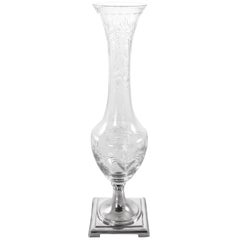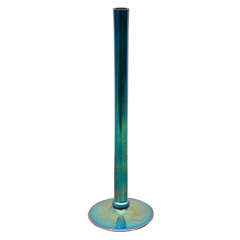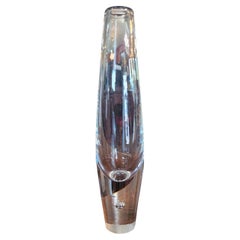Steuben Bud Vase
Early 20th Century American Arts and Crafts Vases
Art Glass
Late 20th Century American Modern Vases
Glass
Vintage 1930s American Art Deco Vases
Art Glass
Antique Early 1900s American Sterling Silver
Sterling Silver
Recent Sales
20th Century American Vases
20th Century American Mid-Century Modern Vases
Crystal
20th Century American Mid-Century Modern Vases
Crystal
Early 20th Century American Arts and Crafts Vases
Art Glass
20th Century American Mid-Century Modern Vases
Crystal
20th Century American Mid-Century Modern Vases
Crystal
Late 20th Century Vases
Crystal
20th Century American Mid-Century Modern Vases
Crystal
Early 20th Century Unknown Art Nouveau Vases
Art Glass
Early 2000s American Glass
Glass
People Also Browsed
Vintage 1960s Italian Mid-Century Modern Decorative Bowls
Murano Glass
Antique 19th Century Jacobean Drop-leaf and Pembroke Tables
Oak
Vintage 1930s French Art Deco Vases
Ceramic
Antique Mid-19th Century Swedish Gustavian Wardrobes and Armoires
Metal
Vintage 1940s American Sterling Silver
Crystal, Sterling Silver
Vintage 1910s American Art Deco Barware
Glass
Mid-20th Century French Mid-Century Modern Vases
Ceramic
Vintage 1930s American Art Deco Wall Lights and Sconces
Bronze
Antique 19th Century English Georgian Sterling Silver
Silver
Vintage 1930s Danish Art Deco Candlesticks
Pewter
Early 20th Century Swedish Scandinavian Modern Vases
Porcelain
2010s American Sterling Silver
Sterling Silver
20th Century American Art Deco Vases
Art Glass, Glass, Uranium Glass
Antique Early 1900s American Edwardian Vases
Silver, Sterling Silver
2010s Philippine Chippendale Bookcases
Mahogany
Vintage 1970s Italian Modern Vases
Art Glass
Steuben Glass for sale on 1stDibs
Steuben Glass Works is the most illustrious name in American art glass. Its vividly colored Art Nouveau and Asian-style wares produced in the early 20th century as well as later modernist works rendered in flawlessly clear crystal are objects of striking beauty and delicacy.
The Steuben Glass Works was cofounded in 1903 in the town of Corning, New York, by Frederick Carder, an alum of celebrated British glassmaker Stevens & Williams and a self-taught English chemist and glassmaker. Carder was a restless experimenter, constantly creating new color formulas that resulted in a wide array of hues, from milky jades to his iridescent Aurene shades. A favorite Carder technique was to acid-etch decorative patterns into pieces made of glass layered in different colors. The forms of his vessels were relatively conservative. Most are based on classic Chinese pottery; many display the flowing, naturalistic lines of the Art Nouveau period.
The larger local firm Corning Glass acquired Steuben in 1918. The company’s approach to art glass changed radically in the early 1930s, when Corning chemists devised a new type of crystal known as 10M, with perfect clarity and brilliant refractive powers. Corning decided that, henceforth, all Steuben decorative objects, vases, sculptures and other wares would be made from the crystal.
Art glass was made in two formats: molded and polished abstract sculptures and figurines, or pieces for which artists used Steuben crystal as a sort of canvas. The first such artwork was sculptor Stanley Waugh’s 1935 Gazelle Bowl, a vessel etched with brawny Art Deco animal forms. In later years, Steuben would invite artists that included Henri Matisse, Georgia O’Keeffe and Isamu Noguchi to “paint” in the firm’s crystal.
Steuben glass comes in myriad forms and is available in a broad range of price points. Jewel-toned glasses and tableware from the Carder era include candlesticks marked at $300 and full dinner services for more than $10,000. Small crystal figurines bring around $1,000, while larger sculptures are priced in the neighborhood of $7,000.
Steuben glass, with its impeccable artistry and timeless grace, deserves a place in any collection.
Find antique Steuben glass and other furniture on 1stDibs.
Finding the Right Vases for You
Whether it’s a Chinese Han dynasty glazed ceramic wine vessel, a work of Murano glass or a hand-painted Scandinavian modern stoneware piece, a fine vase brings a piece of history into your space as much as it adds a sophisticated dynamic.
Like sculptures or paintings, antique and vintage vases are considered works of fine art. Once offered as tributes to ancient rulers, vases continue to be gifted to heads of state today. Over time, decorative porcelain vases have become family heirlooms to be displayed prominently in our homes — loved pieces treasured from generation to generation.
The functional value of vases is well known. They were traditionally utilized as vessels for carrying dry goods or liquids, so some have handles and feature an opening at the top (where they flare back out). While artists have explored wildly sculptural alternatives over time, the most conventional vase shape is characterized by a bulbous base and a body with shoulders where the form curves inward.
Owing to their intrinsic functionality, vases are quite possibly versatile in ways few other art forms can match. They’re typically taller than they are wide. Some have a neck that offers height and is ideal for the stems of cut flowers. To pair with your mid-century modern decor, the right vase will be an elegant receptacle for leafy snake plants on your teak dining table, or, in the case of welcoming guests on your doorstep, a large ceramic floor vase for long tree branches or sticks — perhaps one crafted in the Art Nouveau style — works wonders.
Interior designers include vases of every type, size and style in their projects — be the canvas indoors or outdoors — often introducing a splash of color and a range of textures to an entryway or merely calling attention to nature’s asymmetries by bringing more organically shaped decorative objects into a home.
On 1stDibs, you can browse our collection of vases by material, including ceramic, glass, porcelain and more. Sizes range from tiny bud vases to massive statement pieces and every size in between.
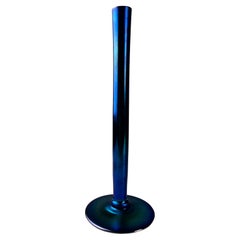
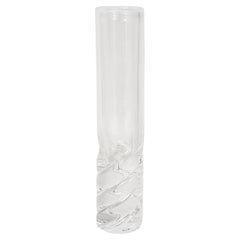
![1930s Art Deco Frederic Carders Blue Aurene Bud Vase [Frog] by Steuben Art Glass 1930s Art Deco Frederic Carders Blue Aurene Bud Vase [Frog] by Steuben Art Glass](https://a.1stdibscdn.com/1930s-art-deco-frederic-carders-blue-aurene-bud-vase-frog-by-steuben-art-glass-for-sale/f_92852/f_371280121700170693998/f_37128012_1700170695482_bg_processed.jpg?width=240)
